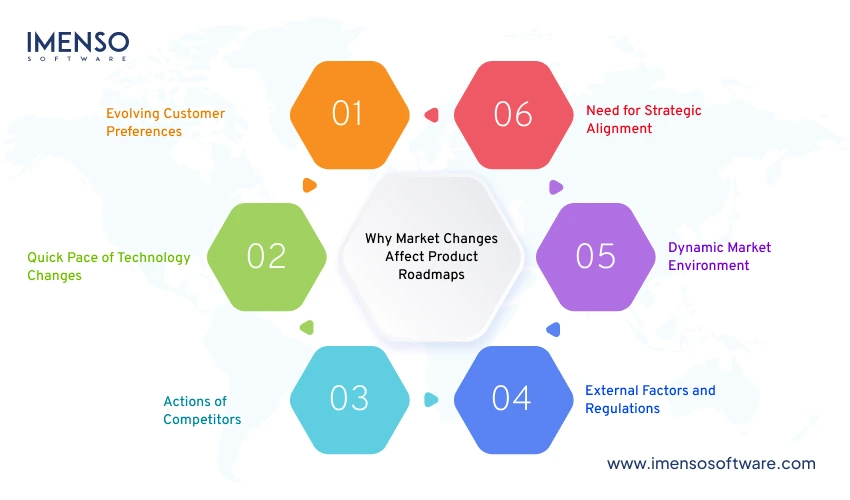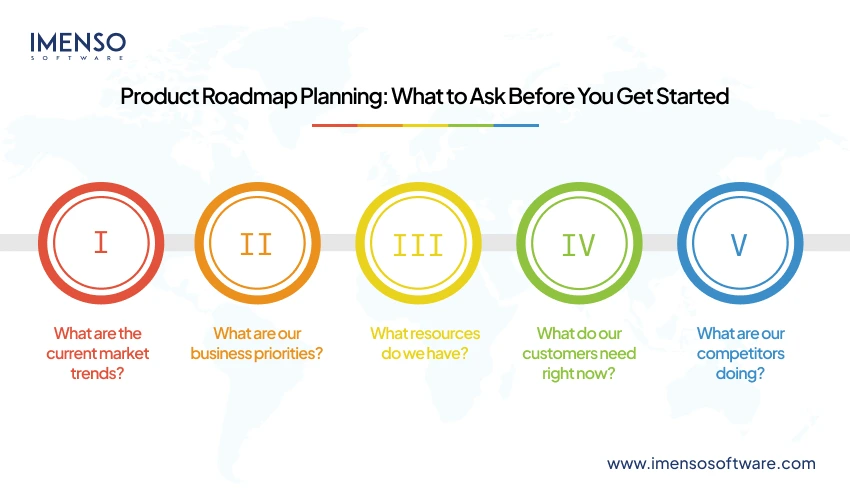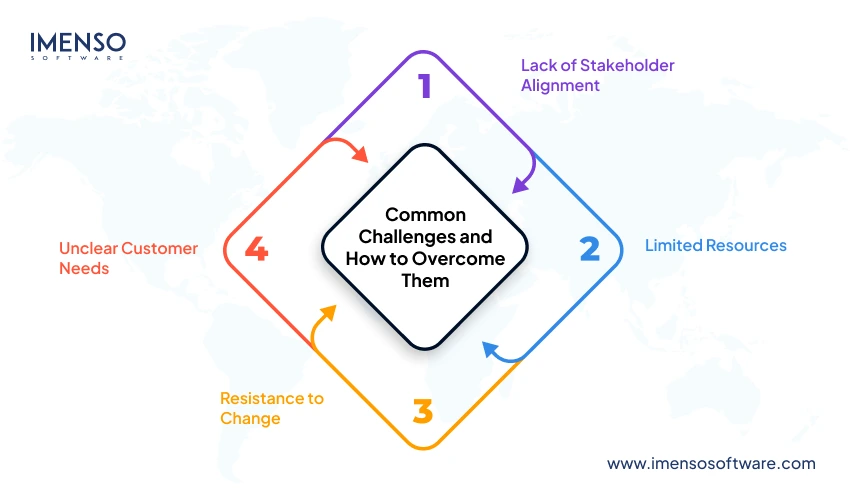Adjusting Your Product Roadmap in Response to Market Changes

Is your product roadmap flexible enough to handle sudden market changes? Market dynamics are constantly evolving and so should your roadmap, what worked yesterday might not work tomorrow. The changes happen so fast that the business cannot keep up leading to obsolete business practices and loss of opportunities. But there is a solution- adjusting product roadmaps.
Your team’s efforts can be directed towards new realities with creating and adjusting product roadmaps. It allows selling to the expectations of customers, making the right change at the right time, and staying ahead of the competition. If these changes are made, one can be sure that the product is relevant and will continue to grow.
In this blog, we will discuss what a product roadmap is, its relevance in times of market disruption, and the ideal way of adjusting product roadmaps. We will also share actionable tips and market-driven strategies to overcome common challenges. So let’s begin without any further ado.
What is a Product Roadmap?
Product roadmaps are very straightforward documents that depict a clear picture of what the objectives are against what steps are needed in order to achieve those objectives. This is great as it clarifies what needs to be built and when, as well as showcasing the timeline for achieving these objectives.
When you want to accelerate growth through Custom Software for Business Growth strategies, adjusting product roadmaps provides great assistance in establishing realistic timelines for certain goals and tasks.
An effective roadmap unites every component of the business including the marketing team and the sales department to coordinate everyone in striving towards a common goal which in turn allows the business to expand at a greater pace.
Why Market Changes Affect Product Roadmaps

Anything from new technology to competitor activity that changes consumer needs can easily render product roadmap updates. To avoid losing out to the competition, and to maintain current relevance with the help of changes in market-driven strategies, quick adaptability is key.
Evolving Customer Preferences
A constant change in customers’ needs and wants urges a market expansion. Trends such as personalization, eco-friendly products, or a greater emphasis on user experience can alter market preferences. A product roadmap that does not consider these factors would likely end up disappointing its customers, resulting in a decline in its sales growth.
Quick Pace of Technology Changes
New technologies are quickly introduced into the market and at times even shift the outlook of what customers are to expect. The moment when one of your competitors integrates IT solutions or IoT technology into their processes, your product instantly becomes obsolete. Adjusting product roadmaps is vital to accompany technology.
Actions of Competitors
Competitor activities could be a major determiner in product roadmap updates. For example, if a competitor has the ability to execute similar features as you, there lies a possibility that you would be forced to speed up your processes. Upon implementation, try to make clients feel different due to a potential resemblance to agile product planning.
External Factors and Regulations
Government policies, economic shifts, or societal changes can pose a hindrance in achieving a set target. For example, new laws regarding data privacy may require a few features to be redesigned. Failure in considering these factors can result in a compliance risk such as the alienation of customers.
Dynamic Market Environment
Market forces such as the growing need for mobile solutions among consumers or changes in the economic environment can render a static roadmap useless. Instead, having a flexible model ensures that the product can adjust to market dynamics at any time.
Need for Strategic Alignment
As market conditions change, your business priorities might also evolve. Adjusting product roadmaps ensures alignment with broader company goals, allowing your product to support overall growth and success.
It is important to remember that no matter how these aspects impact the stages of product development, flexibility is key to ensuring you move fast enough, to take advantage of market opportunities and strategic moves to remain relevant and competitive.
Flexible Product Roadmap Strategies: What to Ask Before You Get Started

Commencing or adjusting product roadmaps requires the right questions to be asked from the very beginning. Such probing questions assist in comprehending the existing scenario, which in turn makes it easier to turn the roadmap into the desired goals.
What are the current market trends?
Market trends are crucial in determining customer requirements and demands that are constantly shifting. Analyze industry publications and customer feedback for insights. This information guarantees that your product roadmap is relevant and future-proof.
What are our business priorities?
Your roadmap must align with the company’s core goals. Focus on projects that are in line with the company’s long-term goals. This alignment assures that the roadmap drives the growth and success of the business.
What resources do we have?
Examine the capabilities of your team including the budget and the timeline. Construct your roadmap to account for what will realistically be possible. Correct evaluation of resource requirements avoids over-commitment and under-delivery of desired results.
What do our customers need right now?
By obtaining customer feedback, the ability to rank the back-end functions that will be crucial in meeting their goals becomes streamlined. Analyze the usage of various surveys and analytics aimed at understanding their requirements. Such an approach guarantees that the roadmap will be tailored to suit customer needs.
What are our competitors doing?
Track competitors’ offerings, modifications, and strategic plans. Their achievements or mistakes can be a source of knowledge. Modifying your strategy based on the business activities of competitors will allow you to remain in the game.
These questions are at the core of good adjustments to the roadmap. They will make sure that the decisions you make are necessary and appropriate at the time.
Adapting Product Roadmaps to Market Changes
Recognizing market shifts and responding by adjusting your product roadmap is fundamental to being relevant and exceeding customer satisfaction. An over-prescriptive roadmap stifles progress and strategy execution, with so many fast-changing opportunities falling through the cracks. Here’s how you can ensure that your roadmap remains adaptable to changes:
Monitor Market Trends Regularly
Always understand the change in the market including the customer’s needs, new devices that are being released, or any action taken by a competitor. By being able to track such changes in the market, you can shift your roadmap according to current needs.
- Stay updated on shifts in customer needs, technologies, and competitors.
- Track market changes proactively to adjust your roadmap.
- Make sure that your product is always relevant to the market.
Evaluate Customer Feedback Continuously
Direct customer feedback is one of the most valuable resources for understanding customer needs and pain points. For this, use surveys, reviews, or even customer support to grey out your roadmap appropriately.
- Look for feedback through surveys, reviews, or even support.
- Remember that customers have a strong voice over any roadmap changes.
- Adjust your features based on real user needs.
Give Importance to Based on Market Relevance
Certain aspects hold greater significance over others depending on the development phase of the product. Regularly go through your roadmap to check if any new features that could fill a gap or show potential in the market are being prioritized.
- Focus on features that align with market demands.
- Regularly reassess which features should take priority.
- Keep up to date with current trends and modify the product accordingly.
Be Ready to Pivot
Behold the possibility of competitors introducing new features that could change your product’s value proposition, don’t be afraid to shift gears if this happens. This could mean accelerating the completion of particular aspects of a feature or even completely re-evaluating the target market for the product.
- Stay adaptable to competitor moves or market shifts.
- Accelerate or innovate in response to new challenges.
- Reassess your intended audience if the need arises.
Align with Business Objectives
Keep an eye on direction changes to make sure they align with the company’s overarching objectives and priorities. Remain flexible to allow product development adjusting product roadmaps making sure they always further enhance long-term growth and targets if needed.
- Keep your roadmap aligned with long-term business goals.
- Adjust product strategy to fit company priorities.
- Maintain flexibility within the company’s broader mission.
Collaborate with Your Team
Active interaction with cross-functional teams makes sure that everyone is aware of the adjusting product roadmaps. Try to interact with everyone on the project and keep them updated regularly so that the project runs smoothly without too many hiccups.
- Encourage open communication with all teams.
- Make it a practice to keep everyone aligned on roadmap changes.
- Keep stakeholders updated to prevent misalignment.
Using these methods, you can easily protect the integrity of the product roadmap while also making sure that it is fit for tackling the market trends.
Common Challenges and How to Overcome Them

Every product roadmap experiences challenges that can prevent progress and impact alignment. Understanding the difficulties that may arise, and how to resolve them, helps in smoother execution and better results.
Lack of Stakeholder Alignment
When working on building a product, confusion is almost inevitable when stakeholders are not equally involved in the process. Personal ideas about tasks aims, and deadlines can prevent people from being aligned in working towards the same goal.
Solution: Schedule meetings to address any communication issues that may cause conflict in achieving goals. Additionally, other tools such as charts and roadmaps can be used to clarify the project’s implicit plans and keep everyone aligned.
Limited Resources
Various limitations can affect the performance of the product such as budget, time, and human resources. Failure to allocate time and manage these resources in the right way will lead to long development cycles or a decline in product quality.
Solution: Conduct cost-benefit analyses and ROI of projects to identify which features need to be prioritized. Also consider outsourcing some tasks, such as hiring software developers from an outsourcing company like Imenso Software with the appropriate skills if you need specific expertise for the project.
Resistance to Change
Members of the team or stakeholders may raise concerns regarding the adjusting product roadmaps, as there is a possibility that there will be an adjustment to the set plans. This opposition could delay the required changes in the marketplace or the emergence of new opportunities.
Solution: Communicate the negative impacts of being inflexible and rigid. Show examples of how modifications to the roadmap might bring about better results, explaining to the team that they have to shift to contemporary business practices to remain relevant.
Unclear Customer Needs
When customer needs are unclear, it can be difficult to create a roadmap that truly resonates with your target audience. This lack of clarity can lead to unnecessary expenses and the loss of an opportunity to satisfy any user requirements.
Solution: Conduct thorough market research before executing. Gather feedback on what customer needs to be met. Make use of interviews, surveys, and A/B testing to obtain and analyze data in real time to be able to fulfill the expectations of the clients.
The use of these solutions makes it possible for you to manage the hurdles effectively. Even beyond that, it offers a window of opportunity for you to improve upon the strategy and make better tweaks.
Also read:
Power BI Embedded Examples: Transforming Applications with Real-Time Analytics
Tools and Techniques for Effective Feature Prioritization
How Agile Software Development Can Empower Startups to Innovate Faster
Wrapping Up
Adjusting product roadmaps is not only for discussion. It is a mandatory requirement that ensures competitiveness amidst changeable markets. Understanding what a roadmap is, the reason it stands prone to market change, and being able to incorporate change within it are fundamentals that advocate the relevance and importance of your product.
Don’t forget that your roadmap should be reviewed regularly and always with some members of your team. Incorporate tools and techniques to make agile product planning and execution more efficient, the most important point of which is to be product/tester/customer oriented and flexible.
Imenso Software focuses on assisting enterprises in the challenge of doing product development and marketing. No matter whether you are searching for Web Development Services or optimizing your roadmap, we have experts who can help you meet your goals.
And, if you are trying to perfect your product strategy, view our services and the ways we can guide you to a successful achievement. Our reviews on Clutch will also assist you in understanding how we helped other companies to grow.
FAQs
What is the main purpose of a roadmap?
A roadmap gives an outline for product development by setting up teams around goals, timetables, and results. It drives decision-making and so gives a clear path to attaining business goals and meeting consumer needs.
What are the benefits of a roadmap?
Roadmaps help to prioritize features, align teams, track progress, and confirm resources are used effectively. They help in managing expectations and communicating the product vision to allow for better collaboration and informed decision-making across teams.
How do you influence a product roadmap?
Gather customer feedback analyze market trends, and work with stakeholders to influence a product roadmap. Align features with business goals, communicate continuously, and be adaptable enough to meet changing market and customer needs.
What is the best way to present a product roadmap?
Outline the product roadmap visually, with timelines, milestones, and priorities. Customize your presentation for audiences including executives working on high-level goals and development teams working on detailed plans. This will ensure greater transparency and easier understanding for everyone involved.
What is the difference between product roadmap and go-to-market?
The strategy of adjusting product roadmaps reflects what goals decision-makers set for the product’s development and provides its features and timelines. However, a go-to-marketing approach outlines how the product is to be realized and sold. The roadmap governs the development of a product, while the go-to-market plan certifies success in adoption and sale.
Want more information about our services?
Similar Posts

Best Practices for Writing Clean and Maintainable Code in Software Development
Did you know that bad code costs companies billions of dollars every year in maintenance and debugging? According to a report, developers spend up to 50% of their time on debugging issues arising from messy and unclear code. That is the time spent that could be used in developing new features or performance improvement. Clean […]...

Leveraging Customer Insights to Find Product-Market Fit
In 2014, Google came up with Google Glass. This was no ordinary glass. It’s a voice and motion-controlled device that displays information around the web right in front of your eyes! Isn’t this invention way ahead of its time?! Alas, if only it could also have a similar impact. Instead of enjoying massive success, it […]...

Best Software Development Services in India: 10 Tips You Need to Follow
Are you looking for the best offshore software development services? Stay along! Software is frequently misunderstood as simply technology, but it is much more. Of course, it is technology, but it is also an intuitive and conscious art. High-quality and reliable software is the foundation of any business, regardless of its size or scope of […]...









